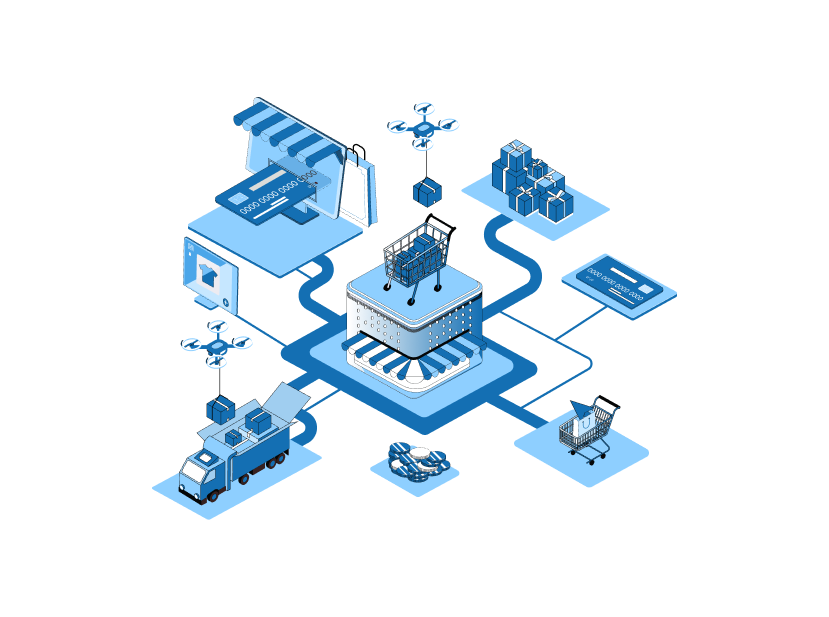Today, almost all industries are utilizing the benefits offered by the Internet of Things. One of the biggest markets affecting the industry, i.e. retail industry, is also encountering an exciting transformation with innovative IoT applications.
Retailers and marketers are enjoying unlimited opportunities with IoT applications to collect and produce more intense insights into customer response and purchasing patterns.
IoT applications aids retailers in increasing productivity, sales and enhances the overall customer experience. Such benefits have improved the image of IoT and made it a centre of attraction among retailers across the globe.
Marketers and businesses expect the revenue of IoT in retail to stretch around 35.5 billion USD by the end of 2025. Today retailers can use IoT technology in their business in different ways to get the most optimal result.
How IoT helps retailers in improving business?
Nowadays, retailers are adopting IoT to enhance customer experience, reduce costs, drive growth and enhance overall performance. Let’s see how IoT supports retailers in improving business.
Smart Shelves:
In a retail business, it has been observed that a considerable amount of time and energy is spent in keeping track of items, i.e. to confirm the availability of a product and know the condition of the product. Using smart shelves is a better solution to end the hassle. IoT technology in retail helps automate monitoring products and reduces the possibility of any possible vandalism.
Retailers attach sensors and RFID tags on the shelves to monitor the products and gather the data. The readers have to scan products on both display shelves and stock shelves.
IoT enabled smart shelve informs the retailer about when items are incorrectly placed on the shelf or running low. It helps to control the management of inventory in a precise and cost-effective way. The RFID tags are attached to a reader that gives the smart shelves the capability to identify in-store thefts. Hence, it cuts off the extra expenditure spend on security personnel.
Automated Checkouts:
Most of the time, store’s checkout counters are the busiest place holding lines of customers for their turn to pay the bills. IoT technology has solutions for this issue as well. It resolves the issue effectively by establishing a system that can read tags on each item when customers leave the store.
The checkout system matches the items with RFID tags and automatically deduct the cost from the customer’s mobile payment application. The automated checkout system improves the customer experience and increases the probability of their revisit to the store for next shopping.
Personalized Discounts:
Loyal customers expect some privileges like personal discounts or rewards for their loyalty. One of the best ways to meet their expectation is setting up sensors that send loyalty discounts to loyal customers when they reach the specific products with their smartphones.
Another way is to adopt IoT to monitor those items that the customer has been searching online and send a personalized discount when the item is available in-store. Through engaging offers Internet of Things can surprise the customers and sustain their loyalty.
Thus adding IoT into a daily business needs foresightedness and creativity. The innovative and smart approach attracts more valuable and long-term customers.
In-Store Layout Optimization:
By Implementing analytics on the data collected using infrared sensors, the store’s layout can be optimized by placing the products at their appropriate place. Also, placing the popular products at the front and least liked at the back can offer a comfortable way to customers to reach the desired item.
Suppose a customer is searching for a popular Smart TV in-store, but it is placed behind an old DVD player’s stock; thus, it is blocking the way to the TV. This inconvenience might result in losing a potential customer. Therefore, in-store layout optimization plays a vital role in a retail business.
The use of IoT applications helps a customer find and locate their desired products in-store, help find the best route to reach their selected items, and check the details of the product provided by the smart shelves.
Optimized Supply Chain Management:
The RFID tags and GPS sensors attached to each product provides precise data about the products’ condition like temperature, humidity, time spent in transportation, and other product-related factors. When the collected data is processed and analyzed to gain insights, it can improve transport and the overall supply chain. In addition, IoT sensors alert the person in charge in case of any emergency and enable them to take necessary actions immediately to avoid substantial loss.
Conclusion:
Internet of Things is transforming the outlook of the retail industry by implementing smart solutions. The adoption of IoT solutions in the retail business can help in improving customer experience, reduce operational costs, improves inventory management and high-quality services.
By extracting valuable insights through IoT and Data analytics, retailers can manage and schedule their operations, including inventory management, supply chain, boost marketing conversions, and ROIs. Thus these features will attract retailers to adopt IoT into their businesses in the upcoming year to enhance their benefits.

